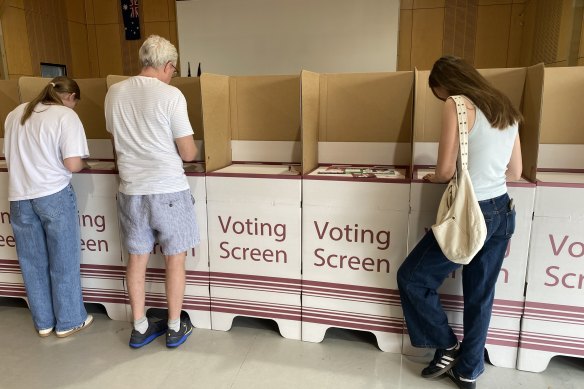- Perspective
- Politics
- Queensland
- Queensland votes
How, where, and by how much Queensland voters shifted to the LNP
By Matt Dennien
It’s now almost weeks since the Queensland state election which delivered power to the LNP for only the third time in 35 years which its leader hopes to make “generational”.
Winning 52 of the state’s 93 seats, the LNP can claim a mandate for the platform it set out (and are), and will face no block enacting it through a parliament it controls.
Ask both sides how they won, and they’ll point to the lengthy period Labor had spent in office. The LNP also highlighting Labor’s record, and public sentiment, on crime and health.

Voters cast their ballots in Brisbane on election day two weeks ago. The final results are now in.Credit: Louise Harris
Coupled with the election of federal Labor since the last state poll, high inflation, interest rates, and cost-of-living pressures, and it was always going to be tough for Labor.
Now that the results are finalised, we can see a clearer picture of how the change played out and how it hides a still-bubbling frustration with the major parties.
A Brisbane Times analysis shows voters in all but three electorates statewide swung (mostly) right towards the LNP on a two-candidate preferred basis – but not all shifts were equal.
Two of these seats were within Labor’s stronghold of Brisbane, where the now opposition had no losses, managed to snatch back South Brisbane and boost its margin in Cooper.
(Though transport minister-turned shadow minister Bart Mellish did only scrape through by 31 votes.)
While Labor’s best result in the broader south-east was winning Ipswich West back after a March byelection loss, this seat also swung big to the LNP compared to 2020.
Further north, and Bundaberg voters seem to have returned to their long Labor roots by boosting Tom Smith’s margin from just nine votes in 2020 to healthier (but still slim) buffer.
Queensland’s voters, the most decentralised in the country, have long been touted as having distinctly regional habits – and the result would appear to show it.
While the bulk of the bigger rightward shifts by voters everywhere else were outside the largely urban south-east corner, more than 10-point swings were delivered there, too.
Overall, some of Labor’s safest seats (Inala, Gladstone) saw the biggest shifts to the right, while some of the most marginal (Cairns, Aspley) experienced the smallest.
This was the case in both the capital city, and in and around the regional ones dotted up the coast.
While none of its five retiring MPs’ seats (Sandgate, Redcliffe, Mackay, Rockhampton, and Mulgrave) were considered marginal, all but one (Sandgate) fell to the LNP.
This alone made up for the three marginal wins the LNP failed to pull off in Cairns, Bundaberg and Aspley – and Labor’s retaking of Ipswich West.
Five of the 18 seats picked up by the LNP will be marginal next election, with all but three of the four Brisbane seats held by the party pre-election pushed deep into safe territory.
The change of government also seemed to trump a sense of changing the two-party system, with both the Katter’s Australian Party and Greens each losing a seat.
Even crossbench margins bled to the LNP as some who had supported KAP or the Greens at the last election ranked the major parties higher.
But this, and the limited change in statewide vote for these regionally specific alternatives, hides the fact that their support bubbled up elsewhere these parties ran.
However, neither KAP nor the Greens finished second in a seat they didn’t previously hold. This partial break fell to One Nation in Southern Downs – on the wrong end of an 18.6 point LNP win.
About one-quarter of voters parked their first preference with a minor party or independent, down from the high-water marks of about one-third in 2017 and 1998.
Electoral analyst Ben Raue said while recent votes in other parts of the country had seen record high minor party votes, and low-water marks for the majors, this had not been the case.
“I don’t think Queensland is at that stage at the moment,” he told me. That’s certainly not to rule it out in the future.
Formal, internal reviews of the election will now be worked through by figures from both Labor and the LNP to rake the ashes for what went wrong, and right.
With both leadership teams heading north to drop into regional cities that helped ushered them into government, or boot them out, you can be sure these will play a role.
Personalities, too. But with the Labor caucus giving Steven Miles and Cameron Dick the leader and deputy roles again, it remains to be seen if these will change once more before 2028.
Meanwhile, the LNP has made a point of ticking-off items from the first week (after cabinet was sworn in) from its first 100-day road map.
Delivery on that, and the new government’s other promises, will be key.
When Queensland voters next cast their ballots, the LNP will have its own record and set of social and economic circumstances for these to be judged against.
We can be thankful such vows aren’t as existential as those made elsewhere.